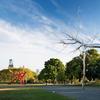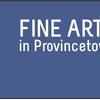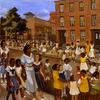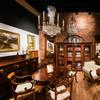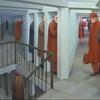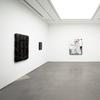
Leftover and Over: Lesley Bodzy and Andrew Orloski at SPRING/BREAK Art Show
New York, NY - What does the historical aftermath of Manet’s Luncheon on the Grass (1863) look like? Leftover and Over, an installation of works by artists Lesley Bodzy and Andrew Orloski, offers a contemporary glimpse into the same woods in l’ le Saint-Ouen, on the River Seine, painted by the enfant terrible of early modern art. In essence, Luncheon on the Grass is a painting about patriarchal voracity—the insatiable consumption of the gaze, the relentless extractionism of toxic masculinity, and the unquenchable desire that only sex and food can instill in us. This is what makes Manet’s painting so powerful and meaningful still today as we come to terms with the idea that atmospheric pollution is not just the result of reckless fuel carbon burning but also of patriarchy and its related logic of conquest and subjugation.
Since the dawn of the industrial revolution, over and over, we have devoured, depleted, and discarded natural resources as if they were endless and as if nature were nothing more than an idyllic backdrop against which to frivolously frolic. Leftover and Over is a quasi-humorous and surrealist-inspired riff on Luncheon on the Grass that calls out this asymmetrical relationship. Cast against a blown up and deconstructed reproduction of Manet’s famous painting, Bodzy’s and Orloski’s work foreground the intricate web of patriarchal and objectifying forces that define our lives today and with that the health of the ecosystems we inhabit.
Manet’s painting stirred up a storm of colossal proportions at the 1863 Salon de Refuses. The brazen nakedness of the female model Victorine-Louise Meurent, and her unapologetic return of the gaze, scandalized Parisian audiences. But was this painting about contemporary decadence—an irreverent depiction of the growing debauchery pervading Parisian youth—or was it more about the freedom of progress and the abandoning of old mores? This tension is central to the painting’s nineteenth-century interpretation as a tableau of contemporary vice, an undesirable manifestation of a certain kind of modern carelessness and youthful frivolity. The perspective of Luncheon on the Grass casts the viewer as a casual voyeur who has arrived late to the picnic—the sex has already happened and not much food is left either. Everything, it seems, was consumed in haste.
The crumpled blanket, and tipped-over basket, in the left-hand corner, suggest a frenzied state of desire. Food leftovers are scattered around. But most importantly, this enigmatic composition reveals the naked truth beneath the hypocrisy of Parisian audiences that would find no problem gazing at the nude body of a Venus but that squirmed in disgust at the sight of the everyday French life they led. Leftover and Over metonymically mirrors Luncheon on the Grass while critically addressing the nature, purpose, and outcomes of the voracity that makes it so haunting and revealing. The work of both Bodzy and Orloski approach materiality as a means through which to negotiate our relationship with reality. They manipulate and cast in order to reveal what is often hidden underneath layers of rhetoric and ideology. Together in this installation, their sculptural objects define a transformative tension that at times gestures towards the allegorical and that at others entirely departs from figuration, leaning towards the transcendental.
In Leftover and Over, Bodzy’s golden veils appear as reimaginations of Manet’s picnic blankets—the 19th century take on Venus’ drapes of modesty and decorum—into emotionally charged and vibrant visualizations of vulnerability, the aftermath of everyday traumas that still define women’s lives today. Thin and yet resistant, the veils allude to the vulnerability of women who, oppressed by patriarchal power, must conceal feelings and emotions beneath a veneer of objectified and appealing perfection. Bodzy’s work is biographical in essence but the aesthetic language she deploys allows viewers to find their place among the narrative outlines that hold every piece together. Each work is a meditation on the patriarchal logic of power and a feminist logic of pleasure shaped by resilience, vulnerability, and strength.
Orloski’s sculptures of trash bags and takeaway boxes are a meditation on our consumptive desire and the hollow feeling that follows our inconsiderate moments of gluttony. The monumentalization of these throwaway objects reminds us of their cultural and ecological permanence in the face of their disposable and cheap everyday materiality. In them is inscribed the paradox that has defined our ravenous hunger for everything from nature to food and sex since the beginning of modernity, as heralded by Manet’s painting—an arrogant mix of unaccountability and patriarchal hedonism that has led us to a planetary crisis.
Ultimately, the transposition and reinterpretation from painterly to installation form proposed by Leftover and Over transforms the viewer from judging puritan or incidental voyeur to an active and implicated participant in the extractive politics that underpin the meaning of Manet’s revolutionary work of art.
SPRING/BREAK BOOTH #1143
curated by Giovanni Aloi and Erica Criss
Lesley Bodzy
Lesley Bodzy’s body of work explores the ways in which materiality can give form and visibility to psychologically complex dimensions. Trauma, loss, and desire are recurring themes she approaches through material processes that she devises as a personal metaphorical language. Her work is represented by galleries in Saugerties, NY, Houston, TX, and Williamsburg, VA. It has been exhibited widely across the United States and abroad. Recent shows include ChaShaMa and Sculptors Alliance in New York City. A selection of her work was recently exhibited at Holy Art Gallery in London, UK, Site:Brooklyn, the Mattatuck Museum in Waterbury, CT, the Susquehanna Art Museum in Harrisburg, PA, the Meadows Art Gallery in Tyler, TX. Bodzy holds an MFA from The School of the Art Institute of Chicago and a BA from Mount Holyoke College. She also studied art at Hunter College, and the Art Students League of New York. Bodzy is based in New York City and Houston.
Andrew Orloski
Andrew Orloski’s sculptural body of work explores notions of monumentalism and banality with an inquisitive look at mundane, often overlooked objects we surround ourselves with daily. His work has been acquired by many private collections worldwide, among others, The Aalborg Art Center, Denmark, which will open in 2023. His practice is represented in Europe by Gallery Nosco (Marseille, Brussels, London). Orloski's recent exhibitions include "The Little Thing that Counts," Brussels, Belgium (2022); "Untitled" Art Fair, Miami Beach, Florida (2021); "Artissima" Art Fair, Torino, Italy (2021); "Stargazers," Los Angeles, California (2021), "Swab" Art Fair, Barcelona, Spain; "Enter" Art Fair, Copenhagen, Denmark (2021) and "The Kinder Garden," Marseille, France (2021). Born in 1986 in West Palm Beach, Florida, and raised in Pennsylvania, Andrew Orloski currently lives and works in Fresno, California. The artist
graduated with an MFA in Studio Art from The School of the Art Institute of Chicago in 2022 and a BFA in Sculpture from Millersville University, Pennsylvania, in 2010.
For press inquiries please contact: info@cultbytes.com

